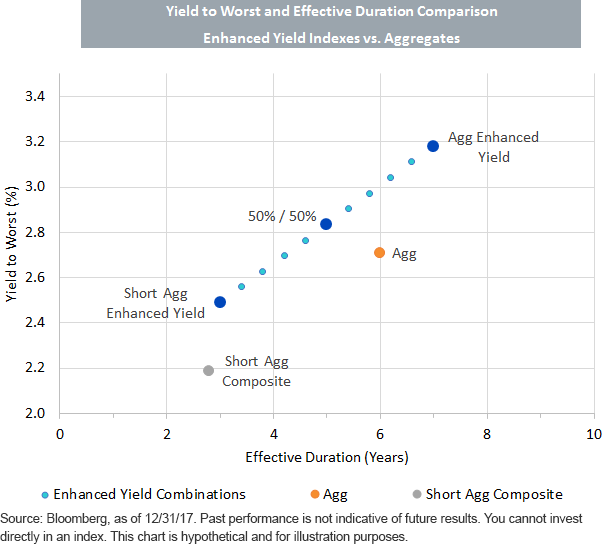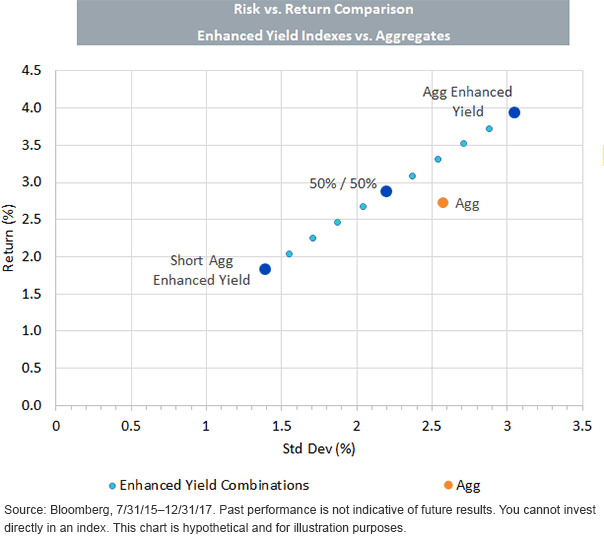Blending Strategies to Outperform the Agg


Over the last several years, we have been vocal advocates of utilizing an updated and enhanced index approach to add value over the traditional Bloomberg Barclays U.S. Aggregate Index (Agg). This has been driven by market forces driving down global interest rates combined with a dramatic shift in bond issuance. As the U.S. Treasury has ramped up borrowing, the sector weights of Treasuries in the Agg ballooned. As a result, the Agg no longer provides investors with adequate income or expected returns, in our view.
In response, we created the WisdomTree Barclays Yield Enhanced U.S. Aggregate Bond Fund (AGGY), which has grown to over $300 million in assets since its launch in 2015.1 Last year, in order to better manage duration targets and extend usage of this concept, we developed the WisdomTree Barclays Yield Enhanced U.S. Short-Term Aggregate Bond Fund (SHAG). In today’s environment, many investors are concerned about rising interest rates. As we show in this post, we believe the blending of yield enhanced core strategies can be a powerful tool for balancing risk/return while at the same time correcting for inefficiencies in the traditional Agg.
Strategy Review
Both the Bloomberg Barclays U.S. Aggregate Enhanced Yield Index (Enhanced Yield) and the Bloomberg Barclays U.S. Short Aggregate Enhanced Yield Index (Short Agg Enhanced Yield) start with the same investable universe as the Agg. However, they seek to enhance yield by optimizing the weights of securities in the index across a variety of sector, credit quality and maturity buckets (subject to a series of constraints). For the short-maturity strategy, eligible maturities are capped between one and five years.
Blending Exposures
Today, we are able to analyze a continuum of portfolios based on essentially the same investment rationale but with varying interest rate risk and income profiles. As we show below, investors could boost income by 27 basis points (bps) while keeping interest rate risk constant by owning a 70% Enhanced Yield/30% Short Agg Enhanced Yield blend. Similarly, investors could keep their income profile on par with the Agg while reducing interest rate risk from 6 years to 4.2 years by owning a 30% Enhanced Yield/70% Short Agg Enhanced Yield blend. For investors interested in boosting income and limiting risk, a simple 50%/50% blend strikes a reasonable balance, in our view.

For definitions of terms in this chart please visit our glossary.
Performance in Real Time
In a recent piece, we highlighted the exceptional live track record of AGGY against its peer group of active managers. As we show below, we believe a blended approach can yield an equally impressive performance record should investors have more discrete duration and interest rate targets. While we have seen periods of rising rates over this analysis period, the fact remains that investors were rewarded for bearing interest rate risk. However, we can also see that more interest rate risk also resulted in a higher volatility portfolio. Volatility can be a good thing when markets are going up but painful when they’re moving down. As such, a simple 50/50 portfolio delivered not only higher returns but also less volatility.

Impact on 2018
In the above hypothetical portfolios, investors substitute greater credit risk for lower interest rate risk. This is precisely the approach we advocated in an earlier post, “How to Avoid Negative Fixed Income Returns in 2018.” Should intermediate-term interest rates rise in 2018 on account of an acceleration in economic growth or inflation expectations, we believe that U.S. investment-grade credit can continue to perform well. As such, we believe investors should take a critical look at their existing approaches to fixed income to see if they’re currently striking the appropriate balance between risk and reward.
1Source: WisdomTree, as of 1/30/18.
Important Risks Related to this Article
There are risks associated with investing, including possible loss of principal. Fixed income investments are subject to interest rate risk; their value will normally decline as interest rates rise. Fixed income investments are also subject to credit risk, the risk that the issuer of a bond will fail to pay interest and principal in a timely manner, or that negative perceptions of the issuer’s ability to make such payments will cause the price of that bond to decline. Investing in mortgage- and asset-backed securities involves interest rate, credit, valuation, extension and liquidity risks and the risk that payments on the underlying assets are delayed, prepaid, subordinated or defaulted on. Due to the investment strategy of these Funds, it may make higher capital gain distributions than other ETFs. Please read the Funds’ prospectuses for specific details regarding the Funds’ risk profile.


